Port Jervis
by John Ceccherelli
Reprinted from "Crown Jewels of the Wire", June 2000, page 17
. . . good potential for insulators and for good reason.
I'd been driving for two hours watching pole after pole of aqua Hemingray
42s. A pure green glint caught my eye. Traveling southeast along route 97 from
Hancock, NY to Port Jervis, normally I would travel on route 17 through the
Catskills. My business in Endicott ended early so I took the opportunity to
enjoy the scenery along the Delaware river and the ex Erie Railroad mainline
that nature had forced to follow its banks. Here in Port Jervis, the color and
character glass I'd been casually watching was a little different.
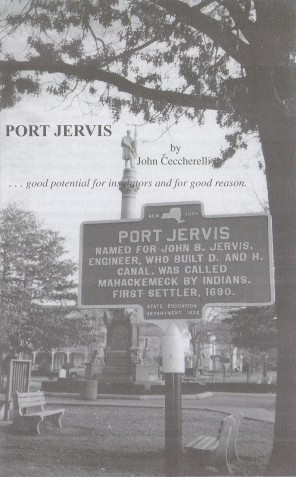
Medium Image (119 Kb)
Large Image (292 Kb)
I stopped the
car and fought my way through some thick underbrush. Crossing what appeared to
be a large ditch, I located the source of the pure green glint. Perched high on
the uppermost crossarm of a telegraph pole, devoid of wires, was a very green
beehive. I glanced at the opposite side of the ditch where the intricate
stonework caught my eye. It spoke of craftsmanship and manual labor one just
doesn't find in the 20th century. And for good reason, I was standing on the
remains of the Delaware and Hudson Canal. 100 plus years since abandonment,
nature had all but obscured its original purpose and glory. But not to the
extent that the railroad had obscured its utility.
Being new to the field of
insulator collecting, I quickly decided that a green anything was worthy of
committing to a vertical ascent. Sparing the technical details, let me say that
20 years of rock climbing and single rope techniques serves one well in this
hobby. It sure opens up access to the uppermost gems that are safely beyond the
reach of discarded railroad tie makeshift ladders. Here at the tip top of the
pole was a bright green "B" beehive that had managed to escape the
ravages of both rocks and BBs.
Port Jervis appeared to have good potential for
insulators and for good reason. Port Jervis has been a communication hub since
it very beginning. Many people mistake the city for a port on the Delaware river
but in fact it was an important port on the D&H canal. The city is located
in southeast New York State in a steep valley carved by the confluence of the
Delaware and Neversink rivers. The D&H canal meanders 108 miles from
Honesdale, PA to Kingston, NY. It generally runs southeast from Honesdale along
the Lackawaxen and Delaware rivers. It then takes a hard left turn at Port
Jervis heading northeast up the Neversink Valley, eventually reaching Kingston,
NY.
The sole purpose of the canal was to transport hard coal from the anthracite region of northeast Pennsylvania to New York City. It was
brainchild of the Wurts brothers who saw the canal as a necessary transportation
evil. They had considered a more direct path to New York but it would have
required tunneling through the Shawangunk mountain range and an elevation gain
of about 1000 feet. At 10 feet per lift lock, the challenge was too great. They
finally opted for the gentler gradient of the Neversink on to Kingston. From
there, it was an easy float down the Hudson to New York City. The canal reached
Port Jervis in 1828.
The city is named after the chief engineer for the canal,
John B. Jervis. Among Jervis's other accomplishments were construction of the
Croton aqueduct providing water for New York City and the Jervis truck (those
little bogie wheels in front of the big drivers) which was instrumental in
keeping locomotives from jumping the tracks on curves. By 1847 the Erie Railroad
had reached Port Jervis as well. When the railroad was finally complete from
Piermont, NY on the Hudson River to the shore of Lake Erie, Port Jervis was to
become an important Division Point along the railroad. It was not long before
the railroad would build extensive shops and service facilities. The railroad
had a far greater impact on Port Jervis than the canal ever did.
A single
telegraph line was in operation along the entire length of the railroad by 1851,
insulated with CD 736's. Ezra Cornell was charged with its construction. A good
choice since it was Cornell who built Samuel F.B. Morse's experimental telegraph
line from Baltimore to Washington, D.C.. Cornell started the Morse line with a
buried conductor. He even designed and patented a trenching machine that is
remarkably similar to the modern day "Ditch Witch". Unfortunately,
Cornell was about 100 years ahead of the times. Insulation problems with the
buried line forced him to find an alternative solution. He suspended the line on
wooden poles and insulated the whole affair with door knobs (or glass plates
depending on who's account you choose to believe).
Cornell would go on to build
many more lines then eventually he would consolidate them into one corporate
giant called Western Union. From a late 20th century perspective, Western Union
is most known for wiring money. In its day, Western Union was a high tech
corporate giant that would have made Microsoft look like a corner deli. Western
Union didn't have total control of Port Jervis, Postal Telegraph would also string lines through Port Jervis. Well... until
Western Union eventually acquired them as well. Later in life, Cornell founded
the university in Ithaca, New York that bears his name. Not a bad list of
accomplishments for one man.
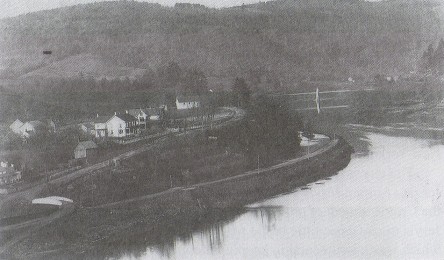
Delaware & Hudson Canal, Pond Eddy, New York,
just north of Port Jervis,
New York, c. 1890's
Erie Railroad on right bank of Delaware River.
(Courtesy of
Minisink Valley Historical Society, Port Jervis, NY)
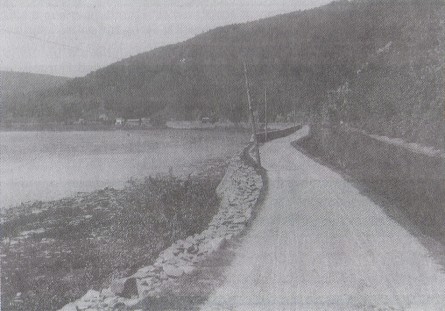
D & H Canal looking north, Pond Eddy, New York, c. 1890
(Courtesy of
Minisink Valley Historical Society, Port Jervis, NY)
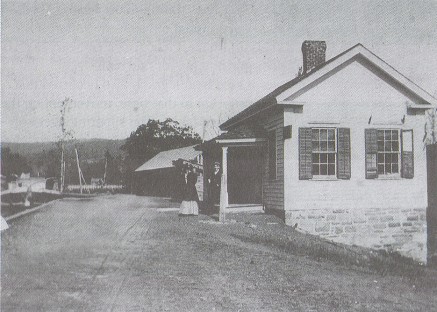
Telegraph Office and Lock Tenders' House, Lock 52
D & H Canal near
Neversink Aqueduct,
a few miles northeast of Port Jervis, New York.
(Courtesy of
Minisink Valley Historical Society, Port Jervis, NY)
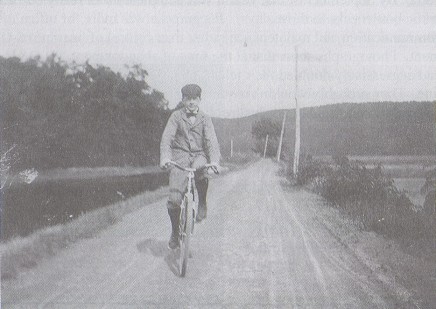
Cyclist on D & H Canal towpath at Huguenot, New York, c. 1900
shortly
after abandonment.
(Courtesy of Minisink Valley Historical Society, Port Jervis,
NY)
The very first train order issued by telegraph also
occurred that year on the Erie RR in Port Jervis. Up to that time, movement on
the railroad was strictly governed by time table. The superintendent of the
Erie, Charles Minot, was growing impatient as he was sidetracked waiting for a
scheduled train to pass. The other train was several hours late due to a problem
west of Port Jervis. Using the telegraph, he ordered the other train to be held
at Port Jervis so his train could proceed. The engineer was unwilling to violate
procedure and the time table so Minot had to personally pilot the train to Port
Jervis. From this time forward, the railroad and telegraph would be inextricably
linked. One telegraph line had grown to 60 as I observed fetching my green
beehive. After the canal was abandoned in 1898, the Erie ran their telegraph
lines along a section of towpath that paralleled their yard in Port Jervis.
The
D&H Canal had petitioned the New York State Legislature for the construction
of a telegraph line along the canal in March of 1862. By September of that year
it was completed (not many bureaucratic bottlenecks in those days). It's purpose
was more for office communication and maintenance rather than control of boat
movement. Photographs show that at the time of abandonment, the D&H had
aggressively doubled their telegraph capacity by adding a second line. They
probably wouldn't require any more than that either. By 1870, railroad freight
rates had reach parity with the canal. The added benefit of speed and year round
operation doomed the canal.
The canal strung their lines on the outside of the
towpath so not to interfere with towlines but at the same time, provide easy
access for repairs. I've searched hundreds of canal photographs for a close-up of
an insulator but so far have found none. It remains a mystery as to what the
D&H used to keep electricity in the wire and off the pole; other than it was
probably glass.
When I arrived at home, I suggested to my able partner, Gregory, that we may want to poke around Port Jervis and perhaps we might find something
interesting. He was up for it as he always is then peppered me with questions
regarding the probability of finding any $10,000 insulators. I told him it was
low and reminded myself to, in the future, keep the price guide away from my 11
year old assistant.
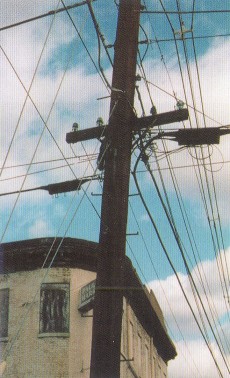
Fire alarm circuits in front of Port Jervis
Train Station, Port Jervis, NY.
Left to right:
Two clear CD 107s (probably Armstrong),
a CD 160 Hemingray-14 in
aqua, and a
CD 202 Hemingray-53 with round drip
points in clear.
The next Saturday, we were off to the fertile crescent of telegraphic
communication, Port Jervis (PJ as it's known by the locals). No sooner did we
hit the city limits and Greg spotted some glass, lots of it, and in an
unexpected place. Main Street, every street. It turns out that Port Jervis' fire
alarm system is open wire on glass insulators, not so surprising given the
history of the town.
The system is operational. Almost entirely circuited on
aqua Hemingray 14 (CD 160) baby signals. A clear Hemingray transposition (CD
202) is used at each alarm box. In some ways, time has stood still in Port
Jervis.
We continued our search which yielded nothing exotic. Eventually we
ended up back on the same towpath that had sparked my interest in the beginning.
We did find some amber carnival Pyrex 63's CD 234 and loads of "B"
hives. No CD 736's but the carnival pieces were a welcome addition to an aqua
sea that our collection is.
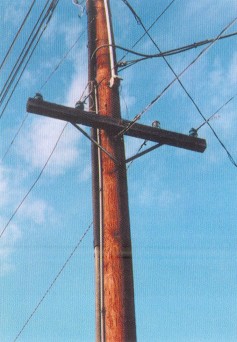
Fire alarm circuits, city of Port Jervis.
Left to right: Two CD 160
Hemingray-14s
in aqua, a CD 107 in clear, and another
aqua CD 160 Hemingray.
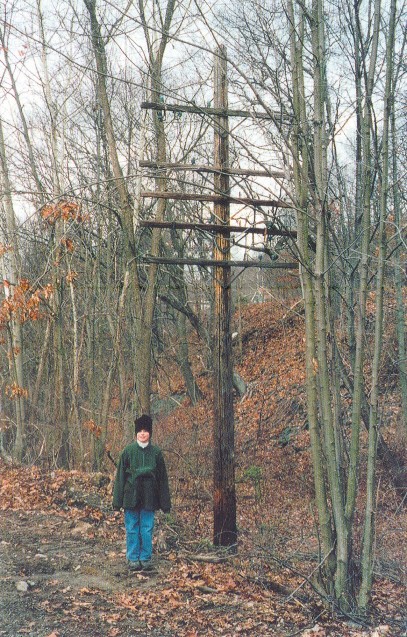
Large Image (365 Kb)
My able assistant, Gregory Ceccherelli (Peanut) on tow path
of the D&H
Canal, December 1999, city of Port Jervis.
Note: The U.S. Coast Guard still
considers the entire 108 miles
of the D&H Canal a navigable waterway!
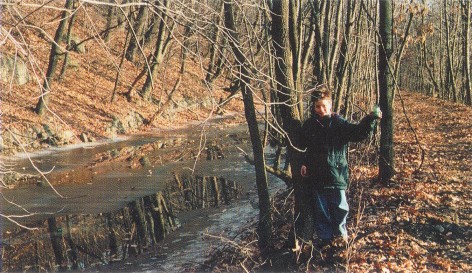
Greg holding a light green "B" hive, towpath of D&H Canal, Port
Jervis.
The more beehives we acquire, the more variability
we find. Even in the same embossing style. Skirt depth, wire groove profile and
outside dimensions seem highly variable. The mold makers at the Brookfield factory must have been very busy. Clearly, the Erie
Railroad purchasing department was happy with Brookfield products. They are
almost exclusively represented on these poles. Finding Brookfield products in
Port Jervis seems appropriate though, the original Brookfield factory was in
Honesdale, Pennsylvania, the western terminus of the Delaware and Hudson canal.
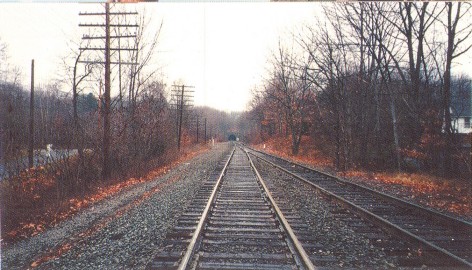
Looking west at Otisville Tunnell, ex-Erie RR (now Norfolk Southern),
Otisville, New York, 10 miles northeast of Port Jervis. Note: 60 to 62 clear
CD
154 Hemingray-42s on these poles.
Port Jervis reached its heyday in the early 1900's. Being a railroad town,
its fortune followed that of the Erie Railroad. When the east coast railroads
had a simultaneous meltdown in the early 1970's, it dealt a devastating economic
blow to Port Jervis. Conrail reduced Port Jervis' role and the city has
struggled ever since. Things have been looking up recently however. Since
Norfolk Southern has taken over the rail line, they see it as critical. Norfolk
Southern is spending millions to upgrade the line through southern New York and
Port Jervis. The lower cost of living here attracts those from the New York City
area despite the hour and 45 minute commute. Port Jervis has passenger rail
service to Hoboken, New Jersey and there are plans for a direct route to NYC.
The economic downturn is directly responsible for the existence of an
antiquated open wire fire alarm system. Where other cities either upgraded or
discarded their old fire alarm systems, Port Jervis has held onto theirs. Lack
of funding has a way of forcing people to make due with what's available.
Perhaps Port Jervis has a fascination with things antique. Despite being
overgrown with rather large trees, unwatered and paved over in spots, the United
States Coast Guard still considers the Delaware and Hudson Canal a navigable
waterway. -- all 108 miles.
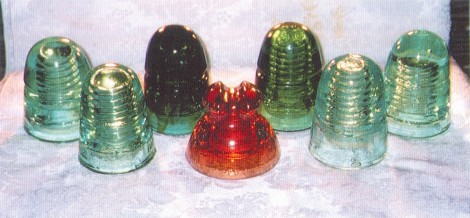
Port Jervis Jewels
CD 145 "B" [035], light aqua and the fattest
beehive I've ever seen;
CD 145 "B" [010], light aqua;
CD 145
"B" [040], emerald green/aqua skirt, pronounced amber streak on skirt
CD 234 PYREX [010], marigold carnival
CD 145 "B" [020], green
CD 145
BROOKFIELD [230], light aqua
CD 145 "B" [020], light aqua, note short
pin hole, 1-1/2" of glass in the crown
While we found no insulators of great value, our Port Jervis experience did
leave us greatly enriched with a sense of history and meaning behind the place.
As is often the case with any journey, you may not find what you were looking
for but what you do find in it's place is usually more intriguing.
Special
thanks and gratitude to Peter Osborne, Director of the Minisink Valley
Historical Society for his priceless help and resources... not to mention hours
riveting anecdotes, stories and an occasional political debate.
Bibliography:
Armstrong, John H., The Railroad, What it is, What it does, 4th
edition, 1998. Simmons-Boardman Boooks Inc., Omaha, NE
Lowenthal, Larry, From
the Coal Fields to the Hudson, A History of the Delaware and Hudson Canal, 1997.
Purple Mountain Press, Fleischmanns, NY
McDougald, John and Carol, Insulators, A
History and Guide to North American Glass Pintype Insulators, Vol 1 and 2, 1990.
The McDougalds publishers, St. Charles,IL
Shaughnessy, Jim, Delaware and Hudson,
1997. Syracuse University Press, Syracuse, NY
Stover, John F., American
Railroads, Second Edition, 1961,1997, the University of Chicago Press, Chicago,
Il
"The Port Jervis Evening Gazette", The Railway Telegraph Systems.
December 7, 1869
"The Port Jervis Evening Gazette", Postal Telegraph,
February 3, 1883
The Tri-states Union, a Bill Before the Legislature, March 14,
1862
The Tri-States Union, Telegraph line, May 2 1862
|
